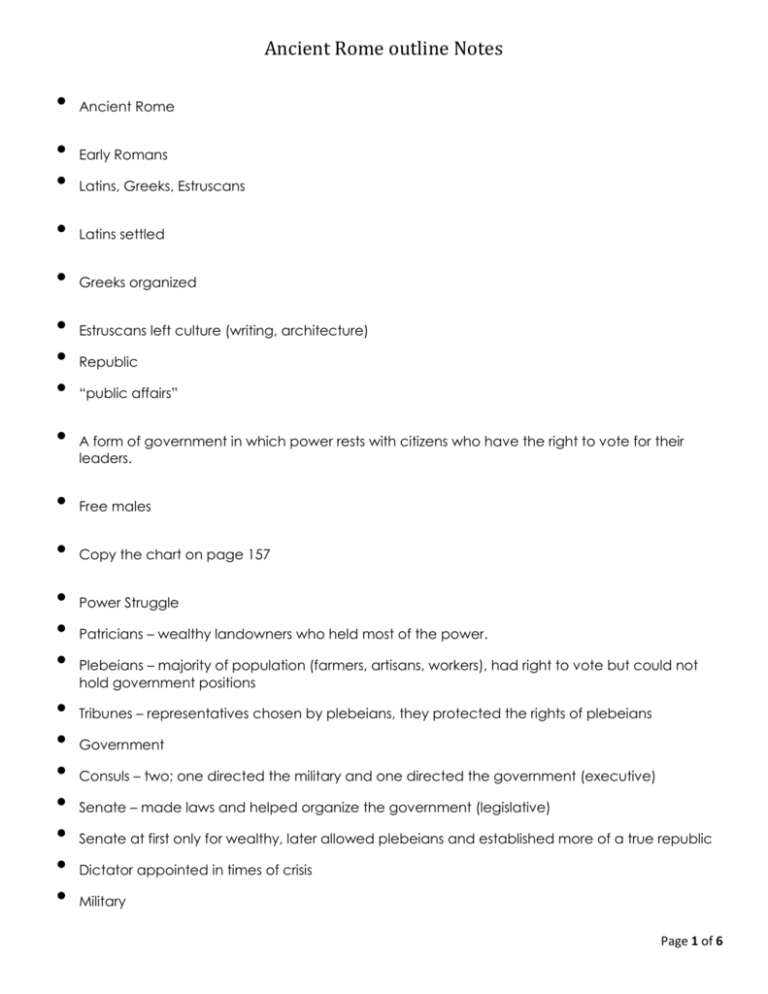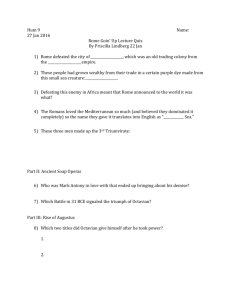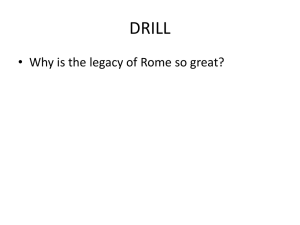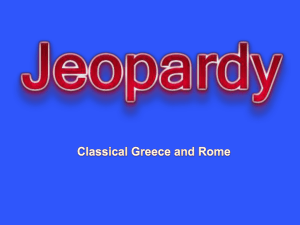Ancient Rome Outline Notes
advertisement

Ancient Rome outline Notes • • • Ancient Rome Early Romans Latins, Greeks, Estruscans • Latins settled • Greeks organized • • • • Estruscans left culture (writing, architecture) Republic “public affairs” A form of government in which power rests with citizens who have the right to vote for their leaders. • Free males • Copy the chart on page 157 • • • • • • • • • • Power Struggle Patricians – wealthy landowners who held most of the power. Plebeians – majority of population (farmers, artisans, workers), had right to vote but could not hold government positions Tribunes – representatives chosen by plebeians, they protected the rights of plebeians Government Consuls – two; one directed the military and one directed the government (executive) Senate – made laws and helped organize the government (legislative) Senate at first only for wealthy, later allowed plebeians and established more of a true republic Dictator appointed in times of crisis Military Page 1 of 6 Ancient Rome outline Notes • All citizens who owned land required to serve • Anyone seeking public office required to serve • Well organized (legions) • • • Military organization and fighting skill helped lead to Rome’s greatness Expansion Defeated all Greeks and Etruscans • Created alliances with conquered people • Allowed others to become Roman citizens • • • • • • • • • • Tolerance helped Rome expand Punic Wars Rome’s location gave it access to all lands around Mediterranean Led to competition Carthage – wealthy port in North Africa Punic Wars – wars between Rome and Carthage Hannibal – leader of Carthage; surprise attack through Alps; highly successful Rome defeats Hannibal with allies, gains control of western Mediterranean COLLAPSE OF THE Republic Gap between rich and poor grew too wide • Small farmers/soldiers became poor • Civil war • • Military leaders cause problems Julius caesar Page 2 of 6 Ancient Rome outline Notes • • • • • • • • • • • • • • • • • Military leader Joined with Crassus and Pompey Triumvirate – a group of three rulers Caesar leads his men to victory in Gaul (France) Pompey fears Caesar’s power and orders him to return Caesar’s troops will defeat Pompey’s troops; he will return to Rome a hero Senate names him dictator for life Caesar’s reforms Ruled as an absolute ruler Granted Roman citizenship to many Expanded the Senate to include supporters from different regions Created jobs New public buildings Started colonies Increased pay for soldiers Caesar’s Death Fearing his growing power, many Senators plot against Caesar • Stabbed to death (23 times) in the Senate chamber • Included his friend Marcus Brutus • • • “Et, tu brute?” Roman empire Upon Caesar’s death, his supporters will defeat the assassins • Octavian joins with a powerful general Mark Antony, and a powerful politician Lepidus • Lepidus forced to retire, Mark Antony and Octavian become bitter rivals Page 3 of 6 Ancient Rome outline Notes • • • • While leading troops, Mark Antony meets Cleopatra Queen of Egypt Civil war arises between Mark Antony and Octavian augustus Octavian defeats Mark Antony and becomes the unchallenged ruler of Rome • Augustus – “exalted one” • Imperator – supreme military commander – emperor • Pax romana • Period of little fighting for some 200 years • Great growth in population and territory • Efficient government and strong rulers • Great buildings • Civil service jobs • • • • • • • • “Roman peace” Empire declines Rulers in the later stage of the Pax Romana did not know how to deal with such a large empire Disrupted trade Raising of taxes Inflation – drop in the value of money combined with a rise in prices Food shortage Disease Mercenaries replace soldiers Page 4 of 6 Ancient Rome outline Notes • • Constantine Diocletian divides the empire to efficiently rule • Constantine gains control of western empire • Then gains control of eastern empire • Moves the capital to Byzantium – Constantinople • • • • • • • Germanic Invasion With capital in east, western empire begins to crumble Germanic people lived peacefully on the borders of Rome Asian nomads called the Huns destroyed all those in their path, forcing the Germanic peoples into Rome Germans begin to overrun Rome Attila Unified 100,000 Huns and terrorized the Roman empire from east to west • Conquered 70 major Roman cities • Roman empire in final stages, Germanic invaders able to take control after Attila’s death • • • • • • • Greco-Roman The mixing of elements of Greek, Hellenistic, and Roman cultures Art reflected Roman ideals of strength, permanence, and solidarity Pompeii – Roman town preserved in volcanic ash, shows evidence of Roman art Virgil – Roman poet who wrote the Aeneid Rome’s Legacy Latin language – adopted by many and developed into other languages Page 5 of 6 Ancient Rome outline Notes • Romance Languages – French, Spanish, Portuguese, Italian, and Romanian • English also influenced heavily by Latin • • Rome’s legacy Grand architecture (Colosseum p.182) • Arch, dome, and concrete invented • Aqueducts – used to bring water into cities, relied on arches p. 181 • Roman roads constructed from stone, bricks, and concrete • Many famous buildings in U.S. based off of Roman architecture (U.S. Capitol) • • • Rome’s legacy Roman law – fair, equal, and applied to all citizens • • • • All persons equal under law Person considered innocent until proven guilty Burden of proof rested with the accuser and not the accused Any law that seemed unreasonable or unfair could be banned Serves as basis for laws around the world Page 6 of 6









